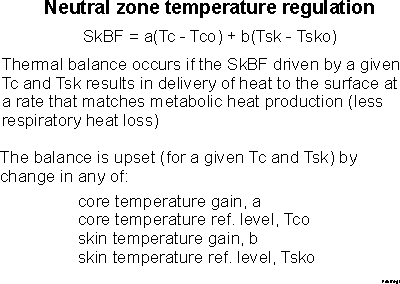
We do not know that control of skin blood flow in the neutral zone will work like control in the hyperthermic zone. The flow levels are much lower in this range where flow is presumably modulated only by vasoconstrictor tone rather than through active vasodilation.

But, the simplest assumption that we can make is that control in the neutral zone is another one of these dual-input proportional systems and that it might be approximated quantitatively by the equation repeated in the graphic panel.
Thermal balance will occur when the skin blood flow is exactly the right level to deliver the right amount of heat to the body surface. That level of skin blood flow is set by the particular levels of core and skin temperature.
This relationship has four parameters, two more than the simple proportional control system described in previous pages. If any of these were to change, then the equilibrium core temperature for a given skin temperature in the neutral zone would change.
Looking at this the other way, if you observed a change in equilibrium core temperature in a person in neutral thermal conditions, you cannot simply write it off as a change in set point. Aside from the possibility that skin temperature might have changed, any of four parameters could have been responsible. We can think of them as two separate "gains," one the sensitivity to core temperature, the other the sensitivity to skin temperature; and two separate "set points" (the term "threshold" would be better), one the core temperature reference, the other the skin temperature reference.
The absurdity of concluding from a change in equilibrium core temperature that the thermoregulatory "set point" has changed is particularly clear if you reflect on the fact that skin blood flow does not belong exclusively to temperature regulation. It also belongs to cardiovascular system regulation. The interaction between cardiovascular regulation and thermal regulation could be through any or all of these four parameters.
The quantitative formulation in the graphic above is obviously an oversimplification of the control scheme for skin blood flow in neutral zone thermoregulation. However, it is complicated enough to show that talking about set points in the neutral zone based on observations of core temperature is meaningless.
Probably the worst example of fallacies that arise from the core temperature set point idea is the tendency to think that some sort of constant reference must exist in the nervous system, against which core temperature is compared. What is necessary for a stable thermoregulatory system in which the same equilibrium core temperature exists under the same thermal conditions is simply a fixed functional relationship of effector output to core temperature and skin temperature (and other variables such as those related to cardiovascular changes). Nothing in nature decrees that a fixed input-output functional relationship in a physiological control system must rely upon some sort of neural apparatus that compares a fixed reference to the stream of input information derived from the body's temperature sensors.
One more thing can be seen with the aid of the simple approximation to thermoregulatory control in the neutral zone described in the graphic panel above. It is simple enough to enable working out estimates of how the reflex effects of shanges in skin and core temperature interact with the physical effects. This kind of analysis leads to a surprising prediction. Given the right ratios of parameters, core temperature might be independent of skin temperature in the neutral zone or even change in the "wrong" direction, i.e., rise when skin temperature falls and vice versa. For an introduction to this analysis, the next page in the sequence, click here